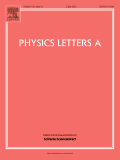
PHYSICS LETTERS A
Scope & Guideline
Advancing the Frontiers of Physics Research
Introduction
Aims and Scopes
- Gravitational Physics and Cosmology:
The journal frequently publishes papers focused on various aspects of gravitational physics, including black hole thermodynamics, gravitational waves, and cosmological models, emphasizing their implications in contemporary astrophysics. - Quantum Mechanics and Quantum Information:
A significant portion of the research covers quantum mechanics, particularly studies related to quantum information theory, quantum entanglement, and quantum computing applications. - Field Theories and Particle Physics:
The journal includes research articles detailing advancements in quantum field theories, particle interactions, and predictions of new particles or phenomena beyond the Standard Model. - Astrophysics and Nuclear Physics:
Papers addressing topics in astrophysics, such as dark matter, cosmic rays, and nuclear reactions, are commonly featured, reflecting the journal's commitment to interdisciplinary research. - Mathematical Physics and Theoretical Models:
Research that develops or applies mathematical frameworks to solve physical problems is a core focus, with an emphasis on novel theoretical models and their implications.
Trending and Emerging
- Quantum Computing and Information Theory:
There is a notable increase in research dedicated to quantum computing, including protocols for secure communication and quantum cryptography, highlighting the growing significance of these technologies. - Modified Gravity Theories and Dark Energy:
Emerging studies on modified theories of gravity, including their implications for dark energy and cosmic expansion, are becoming more prominent, indicating a shift towards exploring new gravitational paradigms. - Interdisciplinary Approaches Combining Physics and Other Disciplines:
The journal is increasingly publishing interdisciplinary research that connects physics with fields like computer science, biology, and material science, reflecting a trend towards collaborative and integrated research. - Quantum Entanglement and Non-locality:
Research exploring quantum entanglement and its implications in various physical systems is trending, indicating a sustained interest in understanding the foundational aspects of quantum mechanics.
Declining or Waning
- Classical Mechanics and Non-Relativistic Physics:
There appears to be a waning interest in classical mechanics and non-relativistic approaches, as the journal increasingly emphasizes relativistic and quantum frameworks. - Conventional Nuclear Models:
Research utilizing traditional nuclear models has decreased, with more innovative approaches and theories gaining favor, reflecting a shift towards more complex and nuanced nuclear physics. - Simple Quantum Systems:
Studies focusing on simple quantum systems and their basic properties are less frequently published, as the journal seeks to address more intricate and relevant quantum phenomena.
Similar Journals
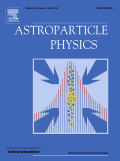
ASTROPARTICLE PHYSICS
Exploring the Cosmic Frontier of Particle PhysicsASTROPARTICLE PHYSICS is a premier international journal dedicated to advancing the understanding of the intersection between particle physics, astronomy, and astrophysics. Published by Elsevier, this journal has established itself as a leading source of research insights since its inception in 1992, with a remarkable impact factor positioning it within the Q1 category for Astronomy and Astrophysics for 2023. With a Scopus ranking of 18 out of 90 in its field, representing the top 80th percentile, ASTROPARTICLE PHYSICS serves as an essential platform for disseminating groundbreaking research that influences astrophysical studies and cosmological theories. Researchers and academics have access to a robust collection of peer-reviewed articles that explore various dimensions of astroparticle phenomena, collaborative cosmic investigations, and theoretical advancements. Although not an open-access journal, it provides extensive research coverage accessible to a global audience from its headquarters in Amsterdam, Netherlands, offering a vital resource for those seeking to push the boundaries of knowledge in the realms of astrophysics and particle physics.
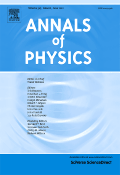
Annals of Physics
Leading discoveries in the realm of Physics and Astronomy.Annals of Physics is a premier journal published by Academic Press Inc Elsevier Science, specializing in the expansive field of Physics and Astronomy. Since its inception in 1957, this journal has played a pivotal role in disseminating high-quality research and advancements across various sub-disciplines of physics. With a notable impact factor making it rank in the Q1 category for 2023, it stands among the top tier of scholarly publications, specifically sitting at Rank #63 out of 243 in the field, placing it in the 74th percentile according to Scopus metrics. Researchers are encouraged to submit their findings to reach a broad audience without the constraints of Open Access fees, promoting extensive visibility within the academic community. As we look ahead to 2024, Annals of Physics continues to be an essential resource for professionals, students, and academics striving to advance the frontiers of knowledge in physics and astronomy.

Journal of Cosmology and Astroparticle Physics
Pioneering Insights into Dark Energy and Particle PhysicsThe Journal of Cosmology and Astroparticle Physics (ISSN: 1475-7516) is a premier publication in the field of astronomy and astrophysics, dedicated to advancing our understanding of the cosmos through innovative research. Published by IOP Publishing Ltd in the United Kingdom, this journal has established itself as a vital resource for researchers, professionals, and students alike, with an impressive Scopus rank of #11/90, placing it in the top 12% of its field. The journal aims to foster the dissemination of groundbreaking studies related to cosmology, dark energy, particle physics, and the universe's fundamental structure, making it a key player in shaping contemporary astrophysics discourse. With a Category Quartile of Q2 as of 2023, it continues to attract high-quality contributions that enhance scholarly dialogue. As an accessible platform, it engages a diverse audience interested in the frontiers of astrophysical research, encouraging collaboration and knowledge sharing among the global scientific community.
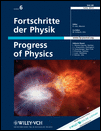
FORTSCHRITTE DER PHYSIK-PROGRESS OF PHYSICS
Pioneering Insights for the Next Generation of PhysicistsFORTSCHRITTE DER PHYSIK-PROGRESS OF PHYSICS, published by WILEY-V C H VERLAG GMBH, is a prestigious academic journal esteemed within the field of physics. With a history spanning over seven decades since its inception in 1953 and a converged publication up until 2024, this journal has established itself as a leading source for groundbreaking research and developments across diverse domains in physics and astronomy. Holding an influential Q1 ranking in the 2023 category of Physics and Astronomy (miscellaneous), it serves as an essential platform for disseminating high-quality research findings and theoretical advancements. Although not an Open Access publication, FORTSCHRITTE DER PHYSIK provides access to critical insights and scholarly discussions that are pivotal for researchers, professionals, and students alike. The journal is committed to contributing to the evolution of knowledge in physics, supporting the academic community through rigorous peer-reviewed articles, reviews, and innovative studies.

EUROPEAN PHYSICAL JOURNAL C
Exploring the Depths of Quantum Field TheoryEUROPEAN PHYSICAL JOURNAL C (EPJ C), published by SPRINGER, stands as a premier platform for innovative research in the domains of Physics and Engineering. With its Open Access policy established in 2014, EPJ C ensures that groundbreaking findings are readily available to the global scientific community, enhancing accessibility and collaboration. The journal, indexed in prestigious databases, boasts an impressive impact factor and ranks within the Q1 category for both Engineering and Physics and Astronomy, placing it among the top-tier journals in these fields. Celebrated for its rigorous peer-review process, EPJ C offers a wide-ranging scope encompassing various topics in particle physics, quantum field theory, and related interdisciplinary studies. Its consistent publication since 1991 has fostered a vibrant community of researchers dedicated to advancing knowledge and innovation in physics and engineering. Join the scholarly discussion and contribute to the cutting-edge research made possible through EPJ C's esteemed platform.

Gravitation & Cosmology
Exploring the Mysteries of the UniverseGravitation & Cosmology is a vital academic journal founded to explore the profound concepts of gravitation and the dynamics of the universe. Published by MAIK NAUKA/INTERPERIODICA/SPRINGER, this journal features a comprehensive range of research articles, reviews, and theoretical insights that advance the field of astronomy and astrophysics. With a current impact factor reflective of its esteemed contribution, Gravitation & Cosmology operates within the upper tier of its discipline, classified as Q3 in Astronomy and Astrophysics for 2023. Although not an open-access publication, the journal fosters a vibrant community of scholars and practitioners by providing rigorous peer-reviewed content accessible through various academic platforms. Covering converged years from 2008 to 2024, this journal serves as an indispensable resource for anyone keen on deepening their understanding of gravitational phenomena and cosmological theories. Researchers, professionals, and students alike will find valuable insights and innovative research that push the boundaries of contemporary astrophysical knowledge.

Physics of the Dark Universe
Illuminating the Shadows of the UniversePhysics of the Dark Universe is a premier academic journal published by Elsevier, dedicated to advancing the understanding of dark matter, dark energy, and their implications for the universe. With its ISSN N/A and E-ISSN 2212-6864, the journal has established a notable presence since its inception in 2012, operating out of Amsterdam, Netherlands. As evidenced by its impressive impact factor and its ranking in the top quartile in both Astronomy and Astrophysics (Q1) and Space and Planetary Science (Q1) categories for 2023, this journal is a vital resource for researchers and practitioners within these fields. In the latest Scopus ranks, it ranks #12 out of 104 in Earth and Planetary Sciences and #13 out of 90 in Physics and Astronomy, placing it in the 88th and 86th percentiles respectively, underlining its academic significance. The journal is not Open Access, yet it plays an essential role in disseminating high-quality research that pushes the boundaries of knowledge about the cosmos and its most enigmatic components. Researchers, professionals, and students interested in the forefront of astrophysics will find this journal an indispensable tool for staying abreast of emerging discoveries and ongoing debates.

PHYSICAL REVIEW LETTERS
Setting the Standard for Rigorous Physics ScholarshipPhysical Review Letters, published by the American Physical Society, is a premier journal in the field of Physics and Astronomy renowned for its rapid dissemination of high-impact research findings. With a distinguished history dating back to 1958 and an impressive ranking of #13 out of 243 in the general physics category, it stands proudly within the Q1 quartile, placing it in the top 6% of journals in its field. The journal focuses on brief reports of significant fundamental research across all areas of physics, making it an essential resource for researchers, professionals, and students seeking to stay at the forefront of developments in their field. Although Physical Review Letters does not offer open access options, its rigorous peer-review process ensures a high standard of quality and relevance in its published articles. With an unwavering commitment to advancing the understanding of physical science, this journal is indispensable for those looking to make a genuine impact in their research endeavors.
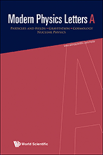
MODERN PHYSICS LETTERS A
Connecting Innovators in Astronomy and High Energy PhysicsMODERN PHYSICS LETTERS A, published by World Scientific Publishing Co Pte Ltd, is a distinguished journal in the field of physics that serves as a pivotal platform for researchers, professionals, and students alike. With ISSN 0217-7323 and E-ISSN 1793-6632, the journal has gained international acclaim for its contributions to Astronomy and Astrophysics as well as Nuclear and High Energy Physics. The journal is ranked in Q3 for both Astronomy and Astrophysics and Nuclear and High Energy Physics, showcasing its relevance in these areas, while also achieving a Q2 ranking in the broader category of Physics and Astronomy (miscellaneous). Spanning from 1996 to 2024, MODERN PHYSICS LETTERS A promotes open dialogue and dissemination of pioneering research findings and innovative theories. While the journal operates without an open access option, its rich content is easily accessible through various academic databases, ensuring that vital research is shared widely among the scientific community. Situated in Singapore, this journal plays an essential role in the continuous advancement of the physics discipline, fostering collaboration and knowledge sharing among global researchers.
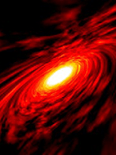
Annual Review of Nuclear and Particle Science
Advancing Knowledge in Nuclear and Particle ScienceAnnual Review of Nuclear and Particle Science is a prestigious journal published by Annual Reviews, focused on the fields of nuclear and high-energy physics. With an impressive impact factor that reflects its authority and influence—ranked Q1 in its category and holding a commendable Scopus rank of #2 out of 87, placing it in the 98th percentile—the journal serves as an essential resource for researchers, professionals, and advanced students alike. Covering pivotal developments and comprehensive reviews in nuclear and particle physics since its inception in 1978, this journal offers unparalleled insights into cutting-edge research and theoretical advancements. While it is not open access, the value of its scholarly content is evidenced by its rigorous peer-review process and its role in shaping contemporary discourse within the scientific community. With contributions from leading experts and a commitment to disseminating foundational and emerging theories, the Annual Review of Nuclear and Particle Science is indispensable for those seeking a deep understanding of the complexities in these dynamic fields.